VOL.45, NO. 4
“Unfriending” Hawthorne
Walter Metz
Near the top of the list of film adaptations that drive literature professors to angry distraction is surely The Scarlet Letter (Ronald Joffé, 1995), a big budget Hollywood version of Nathaniel Hawthorne’s 1850 novel. Beautifully shot and interestingly performed by a diverse range of actors—as Hester Prynne, Demi Moore, a young movie starlet; as Arthur Dimmesdale, Gary Oldman, a British character actor of tremendous range; and as Roger Chillingworth, Robert Duvall, one of the most important American actors of the early New Hollywood generation—the film is nonetheless an assault on Hawthorne’s project.
While feminism and Native American liberation were certainly not foremost in Hawthorne’s mind as he wrote the novel in the 19th century, Joffé’s film reveals Hester Prynne as a 1990s gender warrior and Rev. Dimmesdale as a liberal committed to the just treatment of his Indian brethren, a Dances with Wolves (Kevin Costner, 1990) of the Puritan set.
Is it possible to defend Joffé’s film? Reading the academic literature would indicate that such is an uphill battle. Academics almost universally loathe it, as did the mass media reviewers of the time. James M. Welsh, the founding editor of this journal, declared without equivocation that the film is “an insult to literature of the highest order” (299).
Indeed, the popular reviews were more entertaining than the film itself. Commonweal declared that the “A” stood for “appalling.” Time magazine described the film as “A Scarlet for the Unlettered.” Rolling Stone explained that the film was “Worse Than You Think.” That populist defender of the classics, David Denby joked, “Life is not long enough to watch Demi Moore playing Hester Prynne.” Bruce Daniels summarizes the critical reaction by observing, “Reviewers hated The Scarlet Letter with a vehemence usually reserved for child molesters” (6).
Doth the critics protest too much? Just because Nathaniel Hawthorne’s novel is, as Sacvan Berkovitch declares, “the great classic American novel,” does not mean that films using his characters need to do with them what Hawthorne intended, or what critical orthodoxy demands. We do not hold Shakespeare to this standard when adapting Holinshed, nor should we with Joffé. Demi Moore as Hester Prynne is no more insulting to literature than the American Budweiser is to, of course, far superior German beer.
These are, of course, fighting words with my colleagues, particularly those in literature departments. But let’s step back a bit. Heretofore, there has been one academic defender of the film, Laurence Raw. In his book, Adapting Hawthorne to the Screen: Forging New Worlds, Raw is interested in demonstrating the breadth of cinematic approaches to Hawthorne’s literary output.
Raw deftly details how each film responds to historical and industrial forces. For example, in his analysis of the 1934 version of The Scarlet Letter, the one featuring silent film icon Colleen Moore in her final film, Raw argues that Robert G. Vignola’s film includes comedy interludes because its Poverty row studio, Majestic, was largely only able to distribute its films to conservative-leaning rural movie theaters (12).
Raw even-handedly discusses the merits and limitations of Joffe’s The Scarlet Letter. He laments its linkages to the “conservative costume drama” (129), but simultaneously demonstrates the film’s articulation of Clintonite ideals. In his 1994 State of the Union address, Bill Clinton took a neoliberal stance on crime, arguing that his policy would protect at all costs, “a parent’s right to raise a child in safety and love” (qtd. in Raw, 131). Raw defends Joffe’s film as resonant with its political milieu, arguing that Hester’s “principal concern lies in sustaining the family unit in an attempt to raise her child in an atmosphere of ‘safety and love’” (131).
What I propose in this essay extends Raw’s excellent work in the direction of a more intertextual understanding of Hawthorne and the cinema. For all its convincing analysis of the social and cultural context surrounding the films he studies, Raw is still confined to a one-to-one correspondence between a single Hawthorne work and only one film adapted from it. The table of contents to Adapting Nathaniel Hawthorne to the Screen is a laundry list of film titles that replicate the Hawthorne canon: eight versions of The Scarlet Letter, one House of the Seven Gables (1940), and two versions of The Scarecrow (1972 and 2000).
Much recent work seeks to break the one-to-one correspondence model of the discipline of Adaptation Studies. In the anthology, Adaptation Studies: New Challenges, New Directions, editor Jorgen Bruhn’s contribution argues that we should see adaptation not as a “one-way transport” from novel to film, but instead as a “dialogic two-way process” (69).
In his essay in the volume, “Dialogizing Adaptation Studies,” Bruhn argues, “[A]daptation studies should avoid an exaggerated goal-orientedness (focusing on the end result) and instead try to describe, analyze and interpret the inherent meaning in the process of adapting” (73). For Bruhn, this results in not only insights into how the novel bequeaths thematic and ideological material to the film, but equally important, attention to “the changes being inferred on the originating text” (73). The process of adaptation does not only result in a film that illuminates a novel, it fundamentally changes, irreparably our understanding of that novel. In my current essay, I will enact such a process-based, two-way exchange between the film, Easy A (Will Gluck, 2010) and Nathaniel Hawthorne’s The Scarlet Letter, with 1980s romantic comedies as an interchange between the two.
It is my hope that such a method will illuminate the possibility of a truce between cinephiles and protectors of the literary canon. Such a détente would be built around an understanding of a set of recent films which neither stomp on the sacred ground of literature, but neither are they films—such as Calvin Skaggs’ awfully boring “faithful” adaptations of classic American short stories in his 1980 PBS series, which murder off the vibrancy of the cinema—whose makers simply do not understand how popular culture works to find an audience.
In an angry defense of her own film, Ms. Moore declared, “not many people have read the book” (“Dumb and Dumber”). This is, of course, as dunderheaded as the film’s many historical anomalies. However, the academic historian Bruce Daniels is similarly off the track when he declares that because Hawthorne’s text is “perhaps the most-taught novel in high school and university literature courses” that it necessarily follows that “it is hard to imagine there are many college graduates who have not read it” (1). If one doubts the statistical distance between assigning reading and the literary expertise of graduating college students, I have twenty years of essay exams on Moby-Dick to offer as counterevidence. We need to find a middle ground between Ms. Moore’s underestimating of the populace, and Mr. Daniels’ mirroring over-estimation. Luckily, as with many things, popular Hollywood cinema offers, not the problem exacerbated, but an elegant aesthetic solution.
Let us begin with a moment from Clueless (Amy Heckerling, 1995), a contemporary Hollywood film adapted from a completely different 19th century novel of manners, Jane Austen’s Emma (1815). In the film, our central protagonist is renamed Cher (Alicia Silverstone), and thus Sonny Bono’s erstwhile wife becomes the Budweiser to Austen’s Weihenstephaner. Cher’s friends abandon her in the San Fernando Valley, far away from her home in Beverly Hills. She calls her stepbrother for a ride. He and his girlfriend drive Cher home.
During their conversation, about Hamlet, the girlfriend declares, “As Hamlet said, ‘to thine own self be true.’” With her endearing airhead voice, the backseat Cher gently corrects the obnoxious girl, who responds with mis-educated Harvard snootiness, “I think I know my Shakespeare.” Cher replies that, while she does not know her Shakespeare, she does know her Mel Gibson, and it was in fact “that Polonius guy” who uttered the line in question.
Cher is, of course, completely correct. In this moment, Clueless uses what I call in Engaging Film Criticism a “secondary intertext” to intervene in its project of sculpting a contemporary cinematic universe out of Jane Austen’s 19th century literary one. By using a mash-up of Shakespeare and Mel Gibson, Clueless theorizes how literature works in the contemporary social sphere, contributing as much to appreciate the complexities of late 20th century America as Jane Austen did to understand early 19th century Britain.
Because 1995 America has little to do with 1815 Britain, fealty to the source text is not a productive way of making a compelling movie. Thus, a tutor text of how to read Hamlet becomes far more important to interrogating the world of 1990s high school students than mining Emma for the plot and thematic details so beloved by literature professors in assessing the purported quality of film adaptations.
I begin with Clueless in an argument about The Scarlet Letter because the recent film, Easy A strikes me as a culmination of the development of the teen-pic, moving far beyond the theoretical work begun by Amy Heckerling. Easy A is a masterpiece of sociological understanding of teenagers, housed in an encounter with some plot details from Nathaniel Hawthorne’s novel. In the film, a bright young woman, Olive Penderghast (Emma Stone), is overheard by a Christian gossip while pretending to her friend to have had sex to enhance her reputation. In response to the firestorm of controversy this lie creates among her peers, Olive embroiders a scarlet “A” on her clothing, inspired by her reading of The Scarlet Letter in her English class (see figure 1).
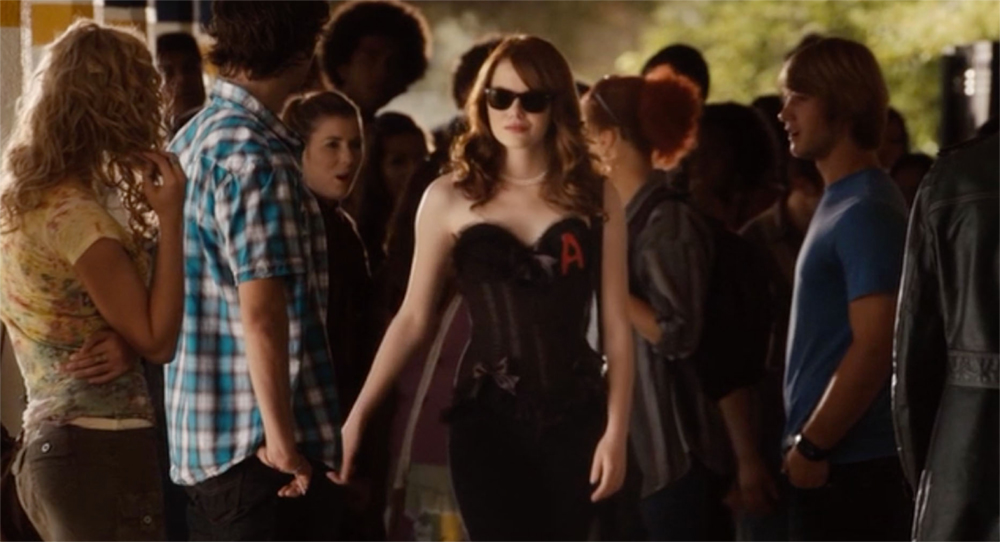
The triumph of Easy A should enable a truce between the proponents of popular culture, such as myself, and the English professors who loathe Joffe’s film. Indeed, Olive, offering a branch to said professors from within her film, explicitly instructs its viewers to not watch the Demi Moore version. Instead, she directs those teenagers who lazily and willfully insist upon not reading the novel—let’s call them the Demi (Agnes) Moore Heads—to instead watch the 1934 Colleen Moore version (see figure 2). Here, Raw is of great use: He demonstrates that the Colleen Moore vehicle already broke ground in the project of rendering comic the project of the overly dour Nathaniel Hawthorne. Raw quotes MPPDA villain, Will Hays: “The movies literally laughed the big bad wolf of the depression out of the public mind” (12). This gives rise to a central question about Easy A: What is Olive laughing her way out of?
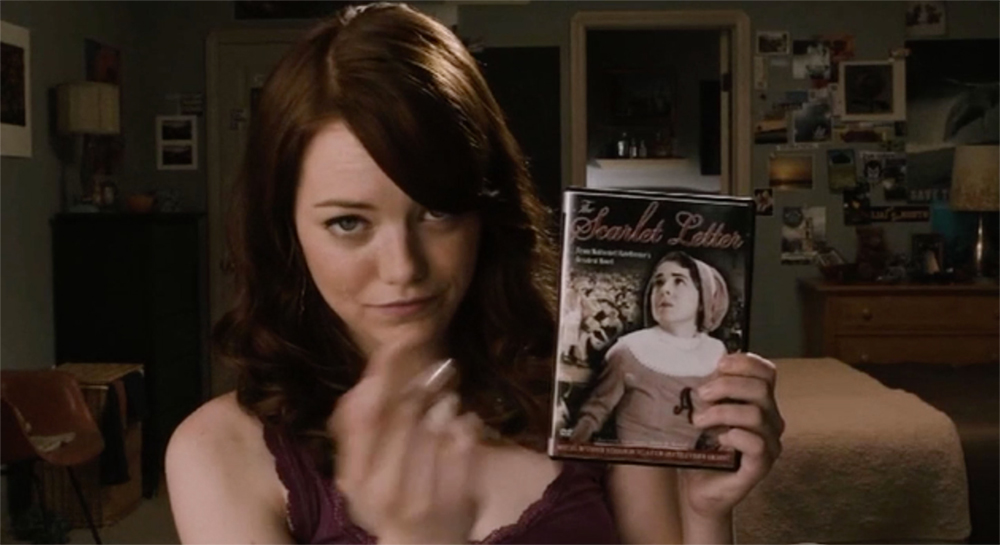
The moves engineered by Easy A offer the academic study of adaptation an opportunity to heal the wounds from the fidelity wars. Easy A is the great compromiser, a smart film which theorizes how to read The Scarlet Letter while at the same time a wonderfully entertaining, popular film about being a high school student in the early years of the 21st century. This is a deeply traumatic experience it would behoove more English professors to consider more carefully in their writing, yes, but even more, in their teaching.
Easy A refuses to cite The Scarlet Letter as its primary source text, a mistake certainly of Joffe’s film, but also of Clueless, and most adaptations in the history of cinema. Olive herself takes care of the first problem, agreeing with the literary critics about the offense of the Demi Moore film. Affecting the Cockney accent of a Dickens chimney sweep, Olive instructs her blog viewers to avoid at all costs “the Demi Moore version where she talks in a fake British accent and takes a lot of baths. To say that one was freely adapted is a bit of an understatement, guv-ner.”
Clueless builds its plot spine around Emma. The encounter with Hamlet is a mere aside, a scene sequence which serves merely to move the Austen plot forward. Not so in Easy A. Gluck’s film forwards the story of the consequences of Olive Penderghast’s lie about having had sex, resulting in an astonishing sequence of intertexts, one of which is a wonderful classroom scene about The Scarlet Letter, but another one being Olive’s tender reflections upon the teen-pics of the 1980s. Significantly, like Hawthorne’s The Scarlet Letter, these films were also authored before Olive was born. As frightening as it is to yours truly, a middle-aged fan of The Breakfast Club (1983) and Ferris Bueller’s Day Off (1986), these films are ancient history to high school students of Olive’s generation, born well after John Hughes made his seminal teen-angst classics (see figures 3 and 4). As a result, Easy A can treat The Scarlet Letter and Can’t Buy Me Love (Steve Rash, 1987), its most important secondary intertext, on equal footing, to astonishing thematic effect.
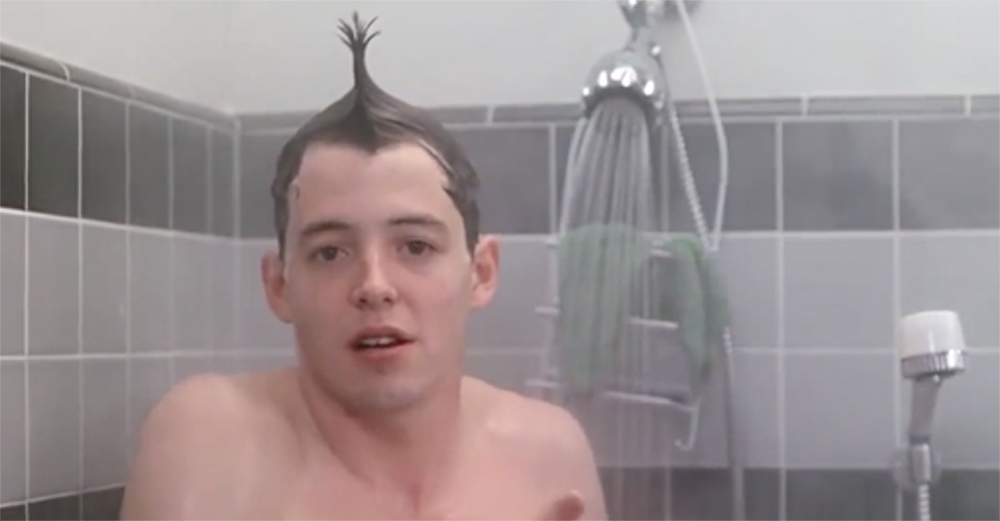

Reflecting upon how low she has sunk, now accepting coupons as payment for lying about having sex with people, Olive tells a story of receiving movie passes only good at the art house theatre in Ojai, CA. We see her stand at the marquee, mangling the pronunciation of Der Scharlachrote Buchstabe (1973), the only film for which her pass is redeemable (see figure 5). Gluck’s film never tells us what Olive thought about seeing Wim Wenders’ updating of The Scarlet Letter, but it is a crucial moment in Easy A, abandoning Hawthorne for a different, surprising set of intertexts (see figure 6).
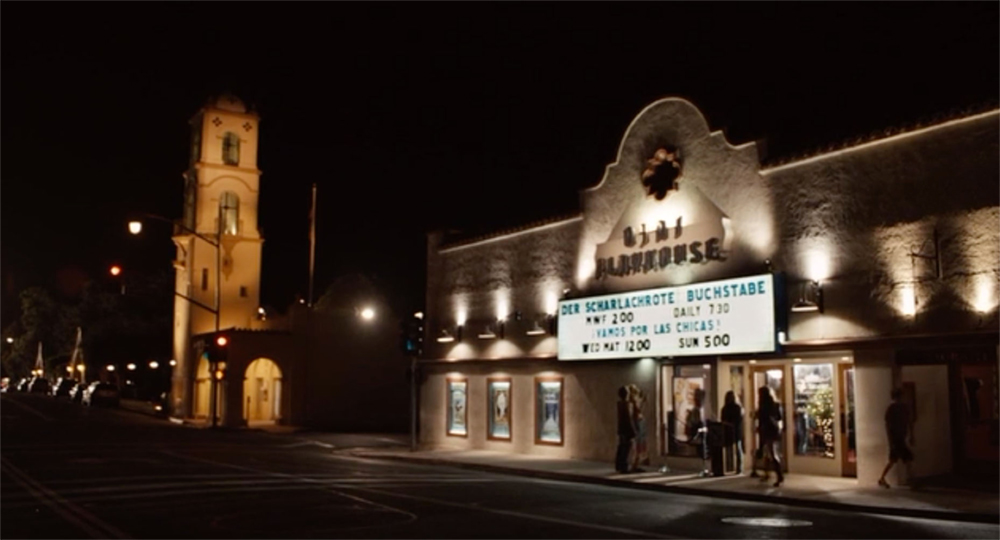
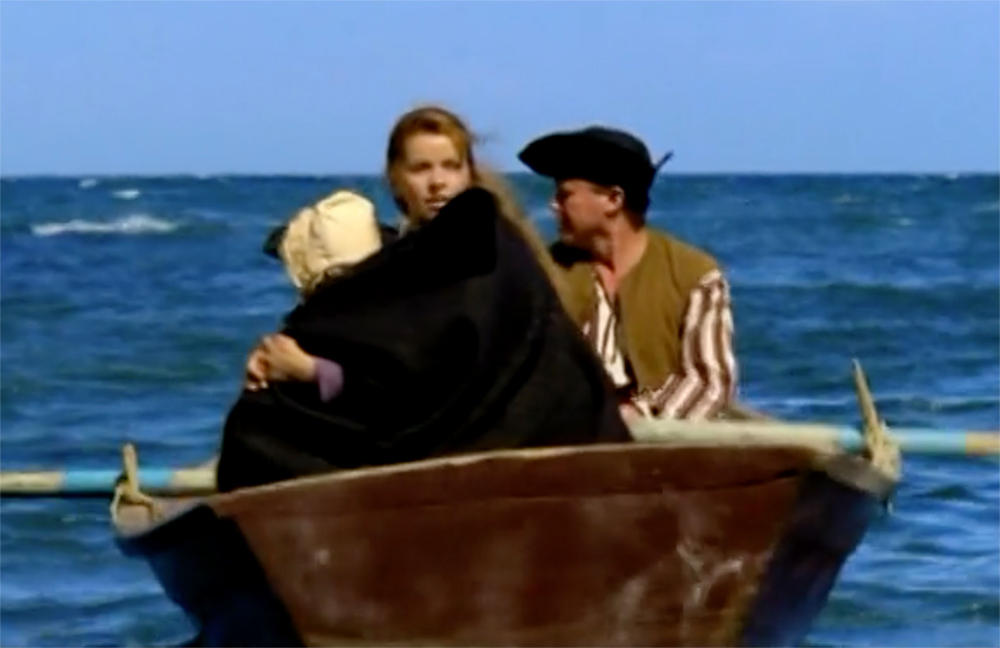
The intertextual collision is intriguing: Does Olive notice that, while her film gives the power of the voice-over to its Hester (Olive herself), Wim Wenders does not, allowing Chillingworth to have that authority? Or, more positively, Raw can lead the way again. In his analysis of the 1973 film, he affirms Wenders’ decision to radically alter the ending of the Hawthorne novel:
[Hester’s] hopes are eventually realized when she boards a ship bound for Providence in a newly written denouement. That she achieves this has been cited as evidence of Wenders’ ‘genuine respect for women.’ This is very different from the novel, where Hawthorne has Hester acquiring strength of character by returning to the Puritan community. (85)
Olive will similarly ride away from the oppressive community of Ojai. However, her vehicle will not be a schooner, but a lawnmower, powered by 1980s romantic comedies.
We never learn the answer to the question of the gendering of cinematic voice, because Easy A leads us down a different, more startling intertextual path. Immediately after seeing the Wenders film, Olive tells the story of a kid in an orange grove who gives her grocery coupons as payment. Olive finds this a pathetic recompense from her phony paramour, observing to him, “I fake rocked your world.” In her bedroom, in close-up into the camera, Olive video blogs her reflections on the state of culture in 2010:
Whatever happened to chivalry? Does it only exist in eighties movies? I want John Cusack holding a boom box outside my window. I want to ride off on a lawnmower with Patrick Dempsey. I want Jake from Sixteen Candles waiting outside the church for me. I want Judd Nelson thrusting his fist into the air when he knows he got me. Just once, I want my life to be like an eighties movie, preferably one with a really awesome music number for no apparent reason. But no! No, John Hughes did not direct my life, so instead of all that I get to save fifteen cents on a bottle of Juniper Breeze antibacterial gel.
As Olive delivers this manifesto, Easy A includes a set of clips from these films, so that her spectators, both inside and outside of the movie, can share in her understanding of the power of popular culture. Thus, Easy A proposes mid-stream during its Act II structural development that Sixteen Candles is as important an intertext for understanding Olive as Colleen Moore-as-Hester Prynne was in the film’s first, expository act. These film clips are privileged as source material, thus colliding high canonical culture with John Hughes movies. And indeed, it turns out that The Scarlet Letter is not the most compelling plot spine for understanding Easy A; instead, the delightfully sweet Can’t Buy Me Love deserves that honor.
Easy A thus teaches us the critical power of taking popular culture seriously, arguing that an otherwise disposable and nearly forgotten 1980s teen-pic is far more interesting in its engagement with The Scarlet Letter than is any prior film adaptation that announces itself as such. Olive’s video blog in Easy A triumphs, proposing with great sophistication, that both popular films and literary texts have great power to influence students’ lives in powerful and productive ways.
The best example of this fusion of film and literature has nothing to do with The Scarlet Letter, but instead with Easy A’s secondary literary intertext, Mark Twain’s The Adventures of Huckleberry Finn (1884). When describing high school English class, Olive observes that it always seems to be the case that the novels they read have something to do with what is going on in their lives.
This point is virtually forgotten by the film until the ending, when in the denouement montage, we learn what has happened to Olive’s queer friend, Brandon (Dan Byrd) in the wake of the public dissemination of her video blog. Olive reports that Brandon, tired of the homophobia in the high school, ran away from home: “He skipped out with some big hulking black guy… My apologies to Mark Twain” (see figure 7).

In the film’s penultimate image, we see Brandon in a hotel room with his not- so-hulking-after-all African-American lover watching a movie on a laptop. It is The Adventures of Huckleberry Finn (Richard Thorpe, 1939), in which Jim (Rex Ingram) and Huck (Mickey Rooney) “skip out” of civilization by floating the Mississippi River on a raft. In as Romantic an image as post-modern America can summon, Easy A photographs Brandon’s and his lover’s smiling faces reflected on the laptop’s screen, on which is a bucolic black-and-white image of Huck and Jim on the raft. In the film playing on the computer, Jim observes, “That’s a might snug-looking shelter,” which applies equally well to Brandon’s new life outside of the stultifying conventionality of his homophobic high school (see figure 8). It is a sentimental image that made me cry: I wonder if it would have broken through that brilliant but nasty Twain’s cynical façade? Can we invent a world in which such an image touches the hearts of English professors?
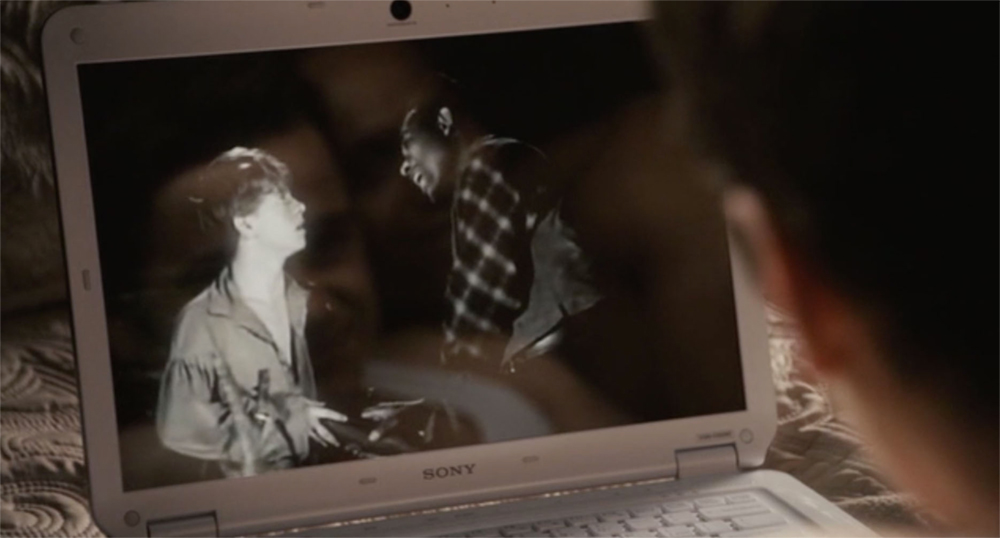
This scene, resolving the “B” plot of Easy A, sets up the resolution to Olive’s story. In the film’s final scene, Olive hugs and kisses her unrequited lover, Todd (Penn Badgley) for the first time. He arrives on a lawnmower, to drive her away to freedom, enacting Olive’s now public desire to live a life directly inspired by 1980s teen-pics.
As Todd does his best Patrick Dempsey impersonation from Can’t Buy Me Love, driving Olive away on the tractor, the film ends with a freeze-frame as Olive and Todd raise their arms together in unison, reproducing the ending of The Breakfast Club. The film thus resolves both of its plot lines with the notion that the movies can chart the way to happiness, if we just know how to read them. And this is as it should be. Cher “knows her Mel Gibson;” Olive loves her 1980s teen-pics, and I am glad to live in a world that encourages me to ponder masterpieces ranging from The Scarlet Letter to Easy A. I think Demi Moore would be proud.
But the big critical payoff from this encounter does not really lie in an exegesis about the merits of Easy A. Instead, Easy A points to the hidden literary treasure that is Can’t Buy Me Love. For only Olive—not her teachers—positions the Patrick Dempsey vehicle as orbiting The Scarlet Letter, and she is devastatingly correct to do so. The value of Easy A does not lie so much in its status as a clever reworking of The Scarlet Letter, the direct mechanism through which it was marketed.
It instead hides a much more radical and interesting project, the notion that 1980s teen-pics, a disposable form of American popular culture to the intelligentsia, are pivotal to the development of late 20th Century American life. The teenagers of the 1980s, and their status as the adult parents of today, are as worthy of our critical attention as the great masterpieces of classic American literature. Can we imagine one hundred years from now studying The Breakfast Club as we now do To Kill a Mockingbird? We ought to, because John Hughes’ artistic voice resonates with those who produce and receive American culture; his reach is far beyond that even of—gasp!—Harper Lee.
Let me put it straight: Can’t Buy Me Love is the most effective film adaptation of Nathaniel Hawthorne’s The Scarlet Letter ever made. What does it mean that it took me twenty-eight years to make this discovery? And, I don’t even get to crow about it as an academic researcher, for I discovered this fact, not through my own critical acumen, but by watching—and taking seriously—the teen-pic, Easy A. When popular films teach us more than literary journals, there’s something rotten in the state of Denmark, and it’s not the fault of “that Claudius guy.”
The Scarlet Letter concerns Hester Prynne, guilty of adultery, holding her infant Pearl on a scaffold, wearing a red letter “A” embroidered upon her frock. The townspeople demand to know who the father is, but she refuses to divulge his identity, scandalously the town’s minister, Reverend Dimmesdale. Hester’s estranged husband, thought lost at sea, returns at this precise melodramatic moment. He demands that the father also be punished, takes on the identity of a physician, Roger Chillingworth, and devotes his life to tormenting the hapless Dimmesdale, whom he quickly identifies as the guilty man.
In the middle of the night, toward the end of the novel, Dimmesdale confesses, but only Hester is there to hear it. She convinces him that they should escape to Europe. He agrees to assuage Hester, but instead delivers his greatest sermon, and then confesses publicly on the scaffold. Dimmesdale dies in Hester’s arms, and Chillingworth, now without a purpose in life, quickly follows. Hester and Pearl retire to their bucolic cottage, apparently living an uneventful life thereafter.
Can’t Buy Me Love concerns Cindy Mancini (Amanda Peterson), head cheerleader, but with a secretly failed romance with Bobby, the high school’s former star quarterback, now a freshman at the University of Iowa. Ronald Miller (Patrick Dempsey) is secretly in love with her, but she only knows him as the nerdy boy who cuts their grass. Ronald has been running a gardening business to save up $1,000 to purchase a telescope.
One night, Cindy decides to go to a party wearing her mother’s fancy suede outfit, which she has been explicitly banned from borrowing. At the party, a drunk boy spills red wine all over the outfit, covering her clothing in the film’s own version of scarlet shame. When her desperate attempts to clean the stain fail, she tries to exchange the outfit at the mall. By good fortune, a new version of the suit costs $1,000.
Melodramatically, from the window of the next shop in the mall, ready to purchase the telescope, Ronald sees his secret love in distress. Instead of making his coveted purchase, he offers Cindy the money for the new outfit. However, his price is that he can “rent” her. His idea is that if Cindy will pretend to be his girlfriend for a month, he will attain the popularity that he has sought but failed to receive. With no other choice, she agrees.
Without Easy A’s conjoining of The Scarlet Letter to Can’t Buy Me Love, there’s absolutely nothing about the film’s plot thus far that would link it to Hawthorne, or render it as at all noteworthy, for that matter. Indeed, I saw Can’t Buy Me Love on videotape with my future wife and her cousin, both of whom hail from The Netherlands; all I can remember is loathing Europeans’ fascination for trashy American culture.
However, with the new reading frame in place, much of the connection to Hawthorne has already been activated. The world of the high school is one of deception and deceit, not all that far from The Scarlet Letter’s pessimistic depiction of Puritan New England. Cindy is Hester Prynne without the pregnancy: she steals the suede, and the rest of the plot follows in consequence of this original sin. Bobby is Chillingworth, thought gone but about to reemerge to stoke the plot. But, what of Ronald? Hawthorne gives us no secret admirer of Hester, waiting in the forest. But Ronald takes on the role of a Dimmesdale, in the sense that he truly loves his Hester, even if completely unable to act upon that love, a failing that woefully Dimmesdale did not suffer in The Scarlet Letter.
Ronald and Cindy share a secret akin to Hester and Dimmesdale, reframed from adultery and the production of a baby, into seemingly petty high school drama. Ronald makes Cindy swear to never tell of their plan because “I mowed 286 miles” for the money he has given to protect her from the punishment of her mother. “This is our sworn secret for life and longer,” he tells her, reenacting a scene from the backstory that Hawthorne does not narrate, but, given Hester’s complete silence in the face of excruciating public humiliation, must have taken place, either explicitly or implicitly.
Ronald’s plan works like a well-oiled machine. With Cindy’s expert assistance, he becomes the coolest boy in the school, having sex with all of Cindy’s friends. However, in the meantime, Cindy has fallen in love with Ronald, coming to realize that his passion for astronomy, for her poetry, and indeed for her, far exceeds her awful relationship with the popular Bobby. But clueless Ronald does not key into this transformation in Cindy, so becomes exactly the jerk that Bobby is.
At the film’s climactic New Year’s Eve party, Cindy exposes Ronald’s lie, revealing him to be the fraud that he is. At this moment, the film’s engagement with The Scarlet Letter turns inside out. Cindy suddenly becomes not Hester, but the Puritans: she places Ronald on the scaffold, outing him as a charlatan. This change is precipitated by Bobby’s return from college. Like the return of Chillingworth, Bobby’s return the night of the party fuels the ending of Can’t Buy Me Love. Indeed, his arrival positions the house party’s living room as the film’s version of the scaffold, the place where public shame and redemption occurs.
Bobby’s role as Chillingworth, the cuckold, motivates the end of Can’t Buy Me Love, as much as it drives the entirety of the plot of The Scarlet Letter. Like everyone else at the party, Bobby thinks Ronald has been Cindy’s boyfriend for the entire fall semester. The transformation affects Cindy’s role as well: she stands on the scaffold with Ronald now as a Dimmesdale figure, exposing the hypocrisy of the kids, as her forbearer did of the Puritans. Cindy cries, “He bought me, but he also bought all of you…. What a bunch of followers you guys are. At least I got paid.” In the aftermath of Cindy’s confession, Ronald, like Hester before him, must retreat to his home, the scourge of the community of hypocrites.
But whereas Hester’s gender position forces her muteness, the film affords Ronald a transformational voice. In the aftermath, Ronald redeems himself. At lunch at school, where kids all sit in their appropriate social groupings, Ronald’s friend Kenneth helps one of the popular girls with her math homework. When one of the popular jocks objects to this breach in social protocol, and threatens his friend, Ronald has finally had enough and stands up to the bully. This second, even more public scaffolding, returns Ronald to the role of Dimmesdale, the one finally empowered to speak publicly against hypocrisy.
Following Easy A’s reliance on social media to explain such teenage angst, let’s say that at this point that Can’t Buy Me Love “unfriends” Hawthorne, leaving his pessimism behind as damaging (see figures 9 and 10). Ronald tells the bully that the social categories “are all bullshit. It’s just tough enough to be yourself.” As Ronald slips away from the community after standing up for his friend, the bully has a sudden change of heart. He shakes Kenneth’s hand and apologizes. The rest of the kids gathered for lunch cheer from their socially defined tables.
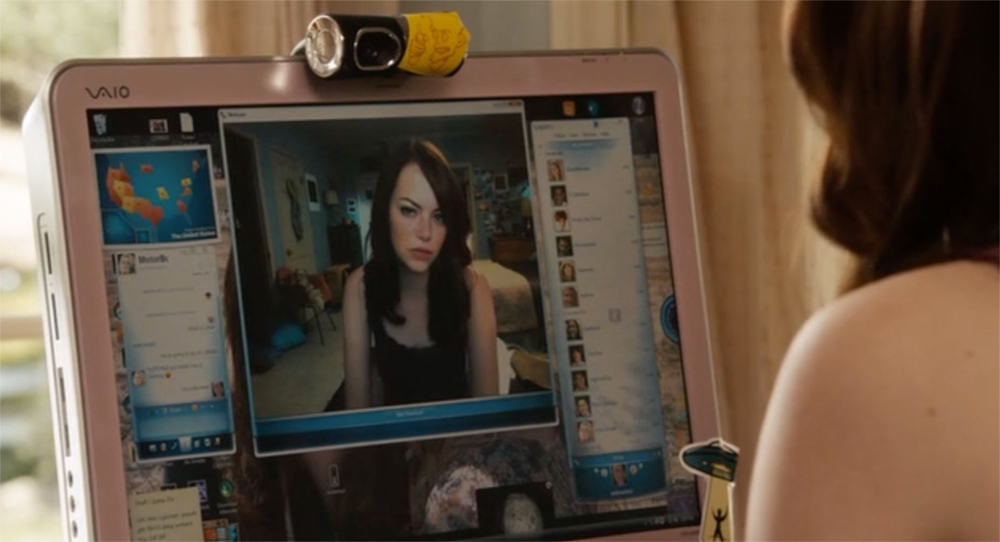
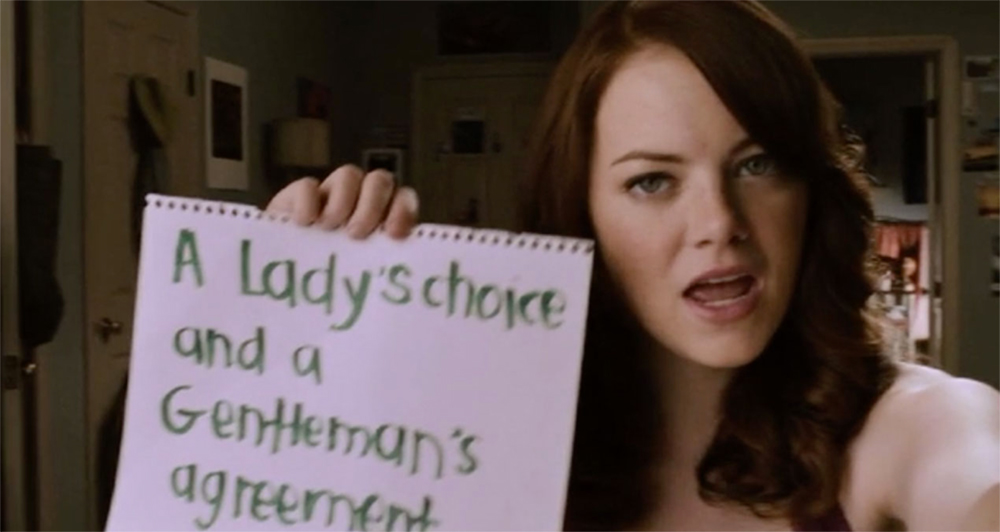
Here, the film does what John Hughes teen-pics did so well; it imagines a world where something better can come of the noble gesture with which The Scarlet Letter ends. The film ends not with death and exile, but with a romantic reconciliation: Ronald drives Cindy down the road to their future on the back of his lawnmower. Can’t Buy Me Love ends with the escape only dreamt of by Hester Prynne, a Romantic world in which Hester and Dimmesdale could live outside of the prescriptions of Puritan New England. Hawthorne does not believe such a place exists, but I have seen it, and live it every day. I thus side with the artists who also believe in its existence, among the foremost being popular filmmaker, John Hughes.
By re-invoking this happy ending, Easy A demonstrates that our use of literature need not be confined to the limitations of the authors who wrote it. It’s fine to see Hawthorne as more realistic, exposing the horrors of hypocritical religion. But The Scarlet Letter, as great a novel as it is, is not the Bible of all human relationships. It is also the case that some of us are lucky enough to have found the “Europe” of which Hester dreams. Hollywood films are not worthless just because they choose to end with a different possibility for the ending of a love story.
With its lawnmower ending, Easy A invokes The Scarlet Letter only to move beyond it, not regress away from it (see figures 11 and 12). It demonstrates that we need not teach our students one fixed meaning of The Scarlet Letter. We only need to come to understand how Hawthorne works, such that we can consider more ably the different choices made by Can’t Buy Me Love. On a road, sable. The tractor, gules.
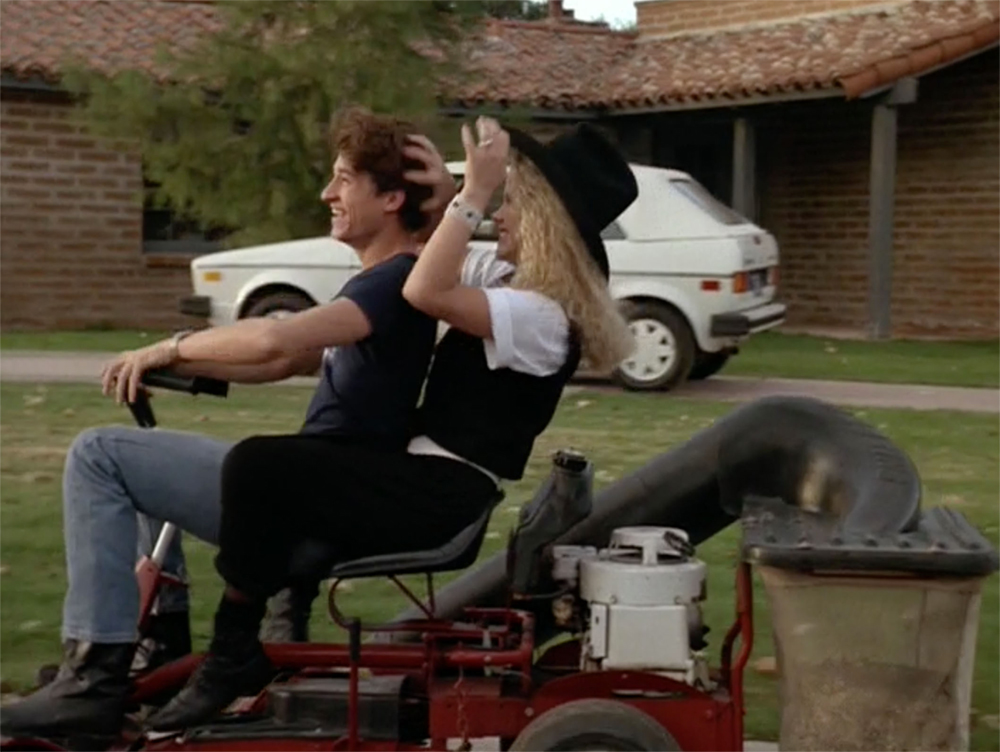
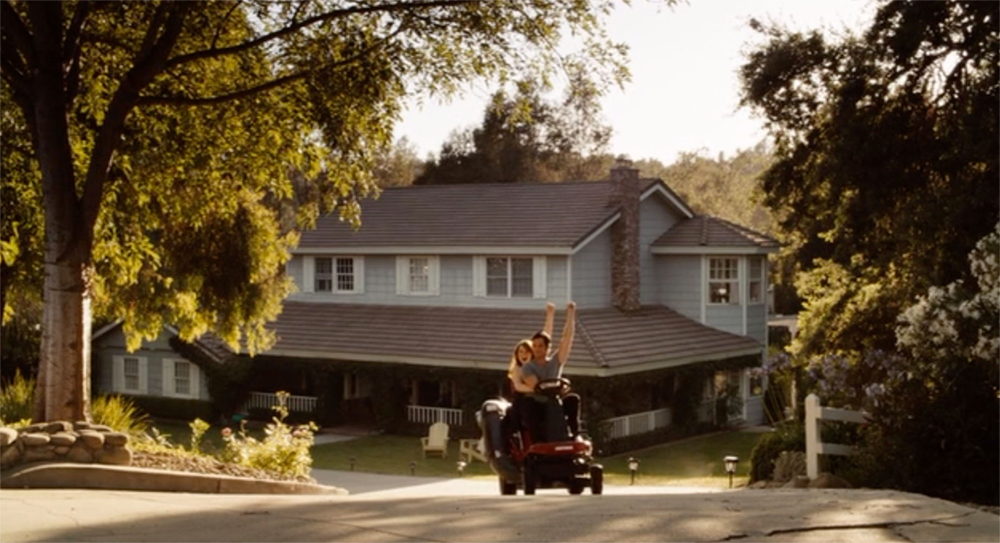
Acknowledgements
This essay is dedicated to my daughter, Emma, my precious olive. To have discovered Easy A together with her in a movie theater is one of the great joys that only cinema, and family, can deliver.
Works Cited
Alleva, Richard. “‘A’ is for Appalling.” Commonweal. November 17, 1995. 20-21.
Ansen, David. “Hester Prynne’s Hot Tub.” Newsweek. October 16, 1995. 87.
Bercovitch, Sacvan. The Office of The Scarlet Letter. Baltimore: Johns Hopkins UP, 1991.
Brouwers, Anke. “The New Mother: Maternal Instinct as Sexual Liberation in Victor Sjöström’s The Scarlet Letter (1926).” Quarterly Review of Film and Video. 24. [2007]. 249-266.
Bruhn, Jorgen, et. al. (Eds.) Adaptation Studies: New Challenges, New Directions. London: Bloomsbury, 2013.
---. “Dialogizing Adaptation Studies: From One-way Transport to a Dialogic Two-way Process.” Jorgen Bruhn, et.al. (Eds.) Adaptation Studies: New Challenges, New Directions. 69-88.
Corliss, Richard. “A Scarlet for the Unlettered.” Time. October 23, 1995. 94.
Daniels, Bruce. “Bad Movie/Worse History: The 1995 Unmaking of The Scarlet Letter.” Journal of Popular Culture. 32.4 Spring 1999. 1-11.
“Dumb and Dumber.” UPI Archives. April 21, 1996. https://www.upi.com/Archives/1996/04/21/People/1720830059200/. Accessed September 11, 2017.
Hawthorne, Nathaniel. The Scarlet Letter. NY: Barnes and Noble, 2003 [1850].
Metz, Walter. Engaging Film Criticism: Film History and Contemporary American Cinema. New York: Peter Lang, 2004.
Phillips, Rod. “Purloined Letters: The Scarlet Letter in Kathy Acker’s Blood and Guts in High School.” Critique: Studies in Contemporary Fiction. 35.3 Spring 1994. 173-180.
Raw, Laurence. Adapting Hawthorne to the Screen: Forging New Worlds. Lanham, MD: Scarecrow P, 2008.
“Scarlet Letter, The: Worse Than You Think.” Rolling Stone. November 16, 1995.
Söderling, Sylvia. “Branding the Body American: Violence and Self-fashioning from The Scarlet Letter to American Psycho.” Canadian Review of American Studies. 38.1 2008. 63-81.
Stade, Nancy. “Introduction” to Nathaniel Hawthorne’s The Scarlet Letter. NY: Barnes and Noble, 2003 [1850]. xiii-xxxi.
Welsh, James M. "Classic Folly--The Scarlet Letter." Literature/Film Quarterly. 23.3 [1995]. 299.